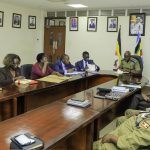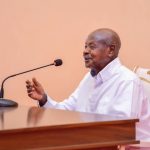Our long held vision of mass-social economic transformation of bonna bagagawale, bonna bagemebwe, bonna basome (prosperity for all, immunization for all, education for all), etc., has been partially implemented and the results are most pleasing to genuine African actors. I captured this story in a book entitled: “From obwiriza to Amatafaari” – “From grass thatched to Amatafaari”.
Fellow Ugandans and, especially the Bazzukulu.
Greetings. Last Friday, 24th May, in the Kisozi area, we had a number of activities. These included: a public meeting at Kisozi Secondary School of wanainchi from the 9 villages around my ranch; present at the Public meeting were a combined Government get-together of the Cabinet; the Speaker and Deputy Speaker of Parliament; the Deputy Chief Justice Richard Butera; some MPs from Gomba and Ssembabule; District chairpersons of Gomba and Ssembabule; Religious Leaders in the area; RDCs; and delegations of Dairy Farmers from part of the Cattle corridor comprised of Ssembabule and Gomba.

I convened this gathering to hear the testimonies of the great and pleasing partial success of the long-held and proclaimed NRM vision of socio-economic transformation of our society from the pre-capitalist non-money society and economy of okukolera ekidda kyoonka (working only for the stomach) to a new society and economy of working for the stomach and the pocket with ekibaro (ensuring adequate financial returns to get families out of poverty).
The dairy farmers delegations from Ssembabule and Gomba, told the gathering of how some of them sell 800 litres of milk per day, another one 1,500 litres per day, others 300 – 400 litres per day. At a price of Ushs. 800 per litre, the one of 800 litres per day would earn Ushs. 233 million per year. Even if the costs were 40%, they would take away Ushs. 93 million from the gross earnings and that would leave a net income of Ushs. 140 million. That is a net monthly income of about Ushs. 12 million.

Besides, those families have coffee, goats, etc. They are definitely out of poverty. This is just a portion of the cattle corridor. This transformation has happened in the whole cattle corridor of Southern Uganda – South of the Nile. This includes the districts of Isingiro, Ntungamo, Mbarara, Sheema, Bushenyi, Kiruhuura, Kazo, Lyantonde, part of Rakai, Kyegegwa, Kabarole, Kamwenge, Kyenjojo, Kiboga, Nakaseke, Kyenkwanzi, Masindi, Nakasongola and Kiryandongo.
These cattle farmers have boosted milk production from 200 million litres in 1986 to now 5.3 billion litres. They have not only saved Uganda the haemorrhage of USD for importing dairy products (liquid milk, powder milk, yoghurt, ghee, butter, etc.) from outside (Kenya, Denmark, New Zealand, Switzerland, etc.) but are also earning USD 264 million per year in export earnings.

Yet, as I pointed out, they have just been partially exploiting the full potential of their farms. Yes, they have fenced the farms, they have provided water in the form of valley tanks or dams and they have bush-cleared the farms by removing the unwanted bushes that starve the grass of the sun-light that the grass needs for its photosynthesis to manufacture its own food.
However, they are still using the free-range methods (kusetura), where the cattle roam freely around the farm. We are now educating them to move to zero-grazing where they grow pasture for the cattle, harvest it and feed the cattle in the shed. This is the Nyakaana Model, the Kizza model (Masaka), the Kalera model, the Kawumu Presidential Farm Model. You can hear that Kalera of Kigumba village, sells 1,500 litres per day from a farm of 30 acres. Many of these farmers have bigger land. Nyakaana is selling 128 litres per day from 1 acre.
Nevertheless, the partial transformation, has enabled these people to migrate from grass thatched huts to matafaari permanent houses, supplied with solar power bought by themselves because they have money and they do not have to wait for UMEME to get them out of darkness, they kulembeka (jolo-pii, kutangiriiza, trapping water) from the roof and use it in the house.
They have also sponsored all the children in the school systems, including university education. Indeed, Nyamwiiza, one of the testimony givers, said that all her children have been through university but have no office jobs. We need to show them that if they move to zero-grazing and diversification (value addition, etc.), they will not only employ their own children but will employ others. Indeed, my daughters, long ago finished their university education.
However, none of them is working for government. They are not only employing themselves, but they are also employing others. Only Gen. Muhoozi is in the army because of his passion for the African Revolution.
Therefore, our long held vision of mass-social economic transformation of bonna bagagawale, bonna bagemebwe, bonna basome (prosperity for all, immunization for all, education for all), etc., has been partially implemented and the results are most pleasing to genuine African actors. I captured this story in a book entitled: “From obwiriza to Amatafaari” – “From grass thatched to Amatafaari”.
By 1995, this success had started being noticed. That is when I started addressing the crops areas that are actually more fertile than most of the cattle corridor. We had started with the cattle corridor because that is where some of us were living. In the crops areas, there was already the problem of land-fragmentation on account of the indisciplined inheritance practices. Therefore, the only correct strategy there, even more than in the cattle corridor, was intensive agriculture rather than extensive agriculture.
With the former, you use a small area but make good money because you are engaged in high value activities, while with the latter, you under take low value activities but on a large scale. You, therefore, get good money with scale.
That is why for the intensive agriculture, we recommend seven activities: coffee, fruits, pasture for dairy, food for the family, poultry for eggs and piggery in the backyard and fish farming. With extensive agriculture for those with big pieces of land, we recommend cotton, maize, tea, sugar-cane, cattle- ranching, etc., etc.
This is what we recommended in our 1996 manifesto. Many efforts have been deployed to implement this: PMA, Entandikwa, NAADS, OWC, etc. Where people have listened, it has worked. That is how you get the Nyakaanas and many more. That is how the percentage of people that are still kukolera ekidda kyoonka (working only for the stomach), has shrunk from 68% to 39%.

Wherever I live, I cannot accept to keep quiet when my neighbours are in poverty. Just like in the wider cattle corridor, in addition to my country-wide efforts, when I moved to the Kisozi area in 1990, I started challenging my neighbours on the issue of poverty. Many of them were poor and unconcerned. Through the patient work of my staff – Joan Kakwenzire, Lydia Balemezi, Komugabe, Nalwanga, etc., the 2,035 families in the 9 villages have started changing. It is those changes that we were witnessing on Friday.
427 families have coffee ranging from ½ acre to 15 acres. Some of them are earning as much as Ushs. 70 million to 100 million per annum, 780 families have dairy cattle – some of them selling 50 litres a day, 4 families are growing fruits. Even when you look at the villages, you see many better houses – permanent ones instead of grass huts or mud and reeds of the 1990s.
Unfortunately, without my knowledge, they have not been giving free coffee and fruit seedlings to the farmers since 2019 because of some people that have been accusing Nalwanga of this and that which made her not to sustain the seed beds. She has now started redeveloping the seed-beds. Anybody willing to work will be assisted, initially, with coffee and fruits. Other items can be added later.
How can the Kisozi model be up-scaled to the whole country? Very easy. Every parish in the country is now getting Ushs. 100 million per parish. The soft loans are Ushs. 1 million per one person or homestead. Ushs 1million is able to give you 450 seedlings of coffee to plant in one acre and 50 seedlings of mangoes to plant in one acre. All this progress is before we add other elements, such as irrigation. Production and earnings will go through the roof.
We ended by visiting the Kisozi farm of our indigenous Ankole cattle. That has been another frontline of the war against the slave mentality of worshipping foreign things and neglecting our heritage. I rejected that slavery (obuhuuku) long ago. I insisted on concentrating the genes of the Ankole long honed cattle against the opinions of Vets and group. The other day the Hon. Rwamirama told us that one of the cattle I sold to NAGRIC is giving 28 litres of milk a day. Of course, I know that because the Kisozi cattle give those levels. We will soon be able to save the farmers the burden of having to struggle with the highly susceptible exotic breeds to the tropical diseases.
Signed:
YOWERI K. MUSEVENI
SSAABALWANYI












